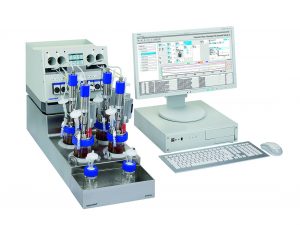 Three-dimensional (3D) culture systems provide cell–cell and cell–extracellular interactions that reproduce the cellular microenvironment in vivo better than typical two-dimensional monolayers. This property is of paramount importance in many applications, including disease modeling, drug toxicity assessment, and manufacturing of stem-cell–based products (1). Cultivation in stirred-tank bioreactors using perfusion mode opens up new possibilities in the cultivation of 3D cell aggregates.
Three-dimensional (3D) culture systems provide cell–cell and cell–extracellular interactions that reproduce the cellular microenvironment in vivo better than typical two-dimensional monolayers. This property is of paramount importance in many applications, including disease modeling, drug toxicity assessment, and manufacturing of stem-cell–based products (1). Cultivation in stirred-tank bioreactors using perfusion mode opens up new possibilities in the cultivation of 3D cell aggregates.
Perfusion allows for removal of detrimental metabolites, cell debris, and proteases from the culture as well as the addition of fresh nutrients. That facilitates longer cultivation periods than are achievable with traditional batch systems (2) and allows for establishing concentration gradients and smooth transitions between growth factor concentrations in a culture medium. Such capabilities are particularly relevant for bioprocessing stem cells or 3D cell models because they can provide a more physiologically accurate in vitro reproduction of in vivo tissue development, ultimately resulting in increased cell yields and/or improved cell functionality and quality (2, 4, 5). One significant challenge in working with perfusion systems is selecting the retention device used to maintain cells within a bioreactor while ensuring continuous medium exchange. Stirred-tank bioreactor hydrodynamics play a critical role in cell survival, growth, and aggregation in 3D spheroids (3). By fine-tuning process parameters such as agitation speed and impeller geometry, it is possible to control the macroenvironment and therefore modulate the cells’ behavior.
Researchers at the Instituto de Biologia Experimental e Tecnológica (iBET) in Portugal have tested the suitability of the Eppendorf DASbox mini bioreactor (Figure 1) for the cultivation of the human tumor cell line H157 as 3D cell aggregates. The team evaluated the impact of impeller geometry on cell growth and aggregate formation. Furthermore, they tested whether an Eppendorf stainless-steel sparger with a pore size of 10 µm could be used as a retention device for 3D spheroids in perfusion culture.
Just fill out the form below to view the full PDF and learn more.
References
1 Serra M, et al. Process Engineering of Human Pluripotent Stem Cells for Clinical Application. Trends Biotechnol. 30, 2012: 350–359.
2 Tostões R, et al. Human Liver Cell Spheroids in Extended Perfusion Bioreactor Culture for Repeated Dose Drug Testing. Hepatology 55, 2012: 1227–1236.
3 Croughan MS, Hamel JFP, Wang DIC. Hydrodynamic Effects on Animal Cells Grown in Microcarrier Cultures. Biotechnol. Bioengin. 29(1) 1987: 130–141.
4 Serra M, et al. Improving Expansion of Pluripotent hESCs in Perfused Bioreactors Through Oxygen Control. J. Biotechnol. 148, 2010: 208–215.
5 Simão D, et al. Perfusion Stirred-Tank Bioreactors for 3D Differentiation of Human Neural Stem Cells. Bioreactors in Stem Cell Biology. Turksen K, Ed. Humana Press: Canada, 2016, 129–142.
Login to read the full PDF of the white paper.

